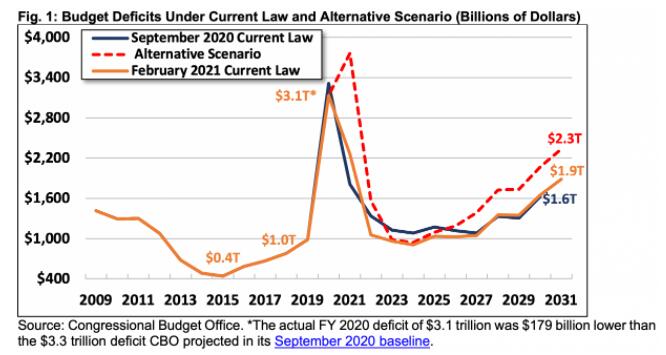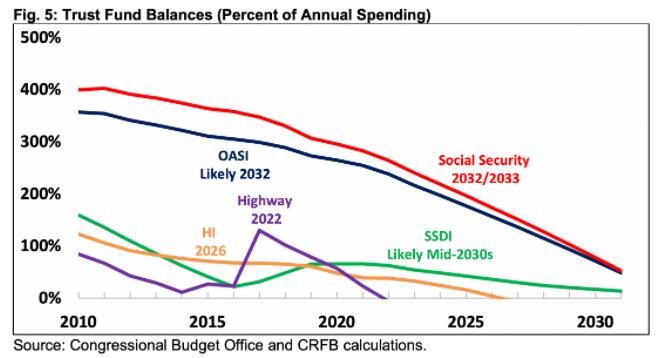In fiscal year 2020, the cumulative balance of federal debt in the United States accounted for 102% of its gross domestic product (GDP). In the year of the outbreak of the novel coronavirus, the cumulative debt station of the United States was at the highest level in more than 70 years after World War II.
The U.S. Congressional Budget Office (CBO) believes that the “debt trajectory” of the United States will remain unsustainable for the next 30 years, and the long-term economic outlook is “dangerous”.
On February 16th local time, the department released the U.S. Long-Term Debt Outlook report and predicted that U.S. public debt would account for 202% of its GDP by 2051. This is equivalent to twice the annual economic output of debt.
According to The Hill on the 16th, according to the forecast of the U.S. Congressional Budget Office on the same day, the annual government deficit level of the United States will go through a decline in previous years after peaking in 2020 and 2021, and then after 2031, it will go through two rounds of rise. By 2051, the cumulative federal debt of the United States will account for 202% of its GDP.
Specifically, in fiscal year 2020, the U.S. government’s budget deficit reached a record 3.1 trillion US dollars, accounting for 14.9% of GDP. The U.S. Congressional Budget Office predicts that the country’s government budget deficit in fiscal year 2021 will reach $2.3 trillion, or 10.3% of GDP, due to the ongoing coronavirus epidemic.
After that, the U.S. fiscal deficit as a proportion of GDP will decline year by year, with an annual average of 4.4%; however, In the decade after 2031, the fiscal deficit of the United States will rise back to 7.9%, and then further soar to 11.5% of GDP between 2042 and 2051.

2031 was regarded by the U.S. Congressional Budget Office as an important inflection point on the trajectory of the U.S. debt, that is, the inflection point of the government deficit level from low to high.
The main reasons behind this may be that several social security and health insurance trust funds in the United States will be exhausted around 2031, and the rising cost of interest on debt.
The office analyzed that in the decade after 2031, U.S. revenue increased only slightly, but spending on health care, social security and interest increased significantly, and the cost of interest alone was expected to account for a large part of the debt.
Between 2042 and 2051, the cost of interest will rise from 1.4% to 7% of GDP.
The Medicare Trust Fund and the Social Security Trust Fund are the two major guarantees for Americans after retirement, but at present, the “lifespan” of both guarantees is not optimistic.
The U.S. Congressional Budget Office expects the hospital insurance (HI) trust fund, which is part of the country’s health insurance plan, to run out by 2026.
The two trust funds of the U.S. Social Security Program, Old Age and Survivor Insurance (OASI) and Disability Insurance (SSDI), are expected to remain solvent by 2031.
However, since 2010, the reserves of both trust funds have declined year by year. The U.S. Congressional Budget Office predicts that the OASI fund will probably be exhausted in 2032, and the SSDI fund will be exhausted in the mid-2030s in a few years.
In addition, the U.S. Highway Trust Fund (HTF) will also deplete its reserves in 2022.

Maya MacGuineas, chairman of the non-profit U.S. Federal Budget Responsibility Committee (CRFB), said that the long-term economic outlook of the United States is “dangerous” and that “ignoring this long-term debt situation will damage economic growth, reduce income and make it more difficult for us.
Addressing backlogs such as income inequality, support for families, and improvements to necessary infrastructure.”
Over the past few years, the “debt mountain” behind the United States has become more and more burdensome, and the arrival of the coronavirus epidemic has exacerbated the debt crisis in the United States.
In January, the Wall Street Journal said that in the four years of Trump’s administration, public-held U.S. government debt increased by $7 trillion to $21.6 trillion.
This has caused the U.S. government’s debt to exceed economic output, making the United States a highly indebted country with economies such as Greece, Italy and Japan.
The Wall Street Journal is worried that Biden’s proposed coronavirus relief plan may further increase the debt of the U.S. government by trillions in the future.
Last year, the United States launched a number of epidemic stimulus plans during the coronavirus epidemic, with a cumulative scale of nearly $3 trillion.
Then Biden proposed a $1.9 trillion coronavirus relief plan.
The outbreak of the coronavirus epidemic has had a significant impact on fiscal policy in the United States, or caused a rise in fiscal deficits and public debt.
However, the Federal Budget Responsibility Committee said that the debt burden of the United States continued to increase before the epidemic.
The committee said that the United States is on an unsustainable fiscal path due to the irresponsible government tax and spending policies before the coronavirus crisis, as well as increased spending on health care and retirement security, and the budget outlook will continue to deteriorate.



